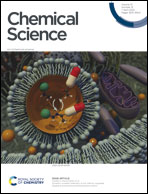Circumventing the scaling relationship on bimetallic monolayer electrocatalysts for selective CO2 reduction†
Abstract
Electrochemical conversion of CO2 into value-added chemicals continues to draw interest in renewable energy applications. Although many metal catalysts are active in the CO2 reduction reaction (CO2RR), their reactivity and selectivity are nonetheless hindered by the competing hydrogen evolution reaction (HER). The competition of the HER and CO2RR stems from the energy scaling relationship between their reaction intermediates. Herein, we predict that bimetallic monolayer electrocatalysts (BMEs) – a monolayer of transition metals on top of extended metal substrates – could produce dual-functional active sites that circumvent the scaling relationship between the adsorption energies of HER and CO2RR intermediates. The antibonding interaction between the adsorbed H and the metal substrate is revealed to be responsible for circumventing the scaling relationship. Based on extensive density functional theory (DFT) calculations, we identify 11 BMEs which are highly active and selective toward the formation of formic acid with a much suppressed HER. The H–substrate antibonding interaction also leads to superior CO2RR performance on monolayer-coated penta-twinned nanowires.



 Please wait while we load your content...
Please wait while we load your content...